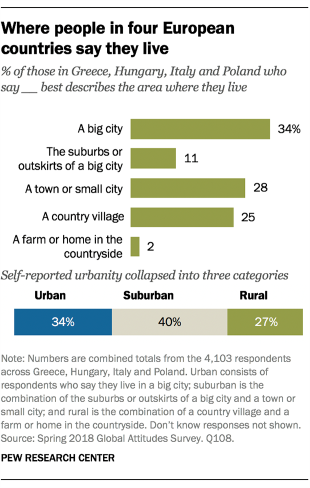In a recent post, we highlighted some of the complications of determining whether communities in the United States are urban, suburban or rural, as well as how official government measures can differ from how survey respondents describe their own communities.
This isn’t just a challenge in an American context. In this post, we’ll look at how the same issue can arise internationally.
Background
A Pew Research Center survey conducted in the spring of 2018 asked people in four European countries — Greece, Hungary, Italy and Poland — to identify what kind of community they live in. Surveys were conducted face-to-face and stratified by urbanity using the degree of urbanization (DEGURBA), which allowed us to compare respondents’ self-reported community type to official government classifications.

Overall, around a third (34%) of the 4,103 respondents across these four countries described the area where they live as a “big city.” Roughly a quarter said they live in a “town or small city” (28%) or a “country village” (25%). Smaller shares described their community as “the suburbs or outskirts of a big city” (11%) or “a farm or home in the countryside” (2%).
To make these descriptions comparable to outside measures of population density, we collapsed the self-reported measures into three categories: urban, suburban and rural (the same categories we use in the U.S.). Those who identified as living in a big city are classified as urban. Those who said they live in the suburbs or outskirts of a big city, along with those in a town or small city, are considered suburban. Those who described their community as a country village or said they live on a small farm or home in the countryside are coded as rural.
#europe #surveys #urban #rural #suburbs #big data
